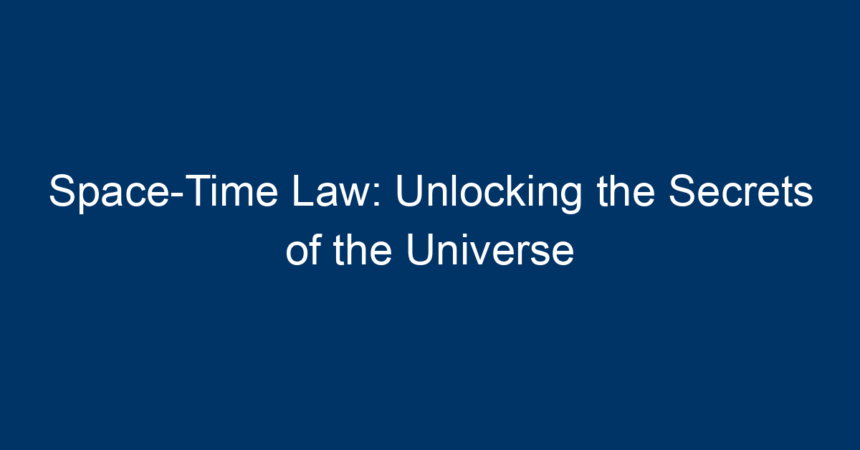The fascination with the cosmos has captivated humanity for centuries. As we stand on the brink of new scientific discoveries, one concept has emerged as a crucial framework for understanding the intricacies of the universe: space-time law. This concept, integral to modern physics, has profound implications not only in theoretical physics but also in our everyday understanding of the world. In this article, we will delve deep into the space-time law, exploring its origins, its implications, and its potential to unlock the secrets of the universe.
Understanding Space-Time Law
What is Space-Time?
The term "space-time" combines the dimensions of space and time into a single continuum. This revolutionary idea was primarily developed by Albert Einstein in his theories of relativity.
- Space encompasses the three dimensions we can perceive: length, width, and height.
- Time is often seen as a separate entity, but in the framework of space-time law, it becomes an intrinsic part of a four-dimensional fabric.
The Birth of Space-Time Law
Einstein’s theories challenged the classical Newtonian views of physics. In his groundbreaking 1905 paper on special relativity, he posited that the laws of physics are the same for all observers, regardless of their relative speeds. This led to the understanding that time can stretch or compress—a phenomenon resulting from speed and gravity.
In 1915, Einstein expanded this idea into his general theory of relativity, introducing the concept that massive objects like planets and stars warp the fabric of space-time, which in turn governs the motion of these objects.
The Mathematics Behind Space-Time Law
The Equations that Changed the World
Einstein’s equations of general relativity describe how matter influences the curvature of space-time. The most famous of these can be summarized as:
[
G{\mu\nu} + \Lambda g{\mu\nu} = \frac{8\pi G}{c^4} T_{\mu\nu}
]
In this equation:
- (G_{\mu\nu}) is the Einstein tensor, representing the curvature of space-time.
- (\Lambda) is the cosmological constant, addressing the energy density of space.
- (g_{\mu\nu}) is the metric tensor, describing the geometry of space-time.
- (T_{\mu\nu}) is the energy-momentum tensor, representing the distribution and flow of energy and momentum.
These equations not only describe gravity but also provide insights into the universe’s expansion and the existence of black holes and gravitational waves.
The Implications of Space-Time Law
The implications of space-time law are profound and far-reaching. It reshapes our understanding of existence, time, and the universe:
- Gravitational Effects: Massive objects create gravitational wells in space-time, influencing other bodies’ motion.
- Time Dilation: The closer you are to a massive object, the more time slows down. This has practical applications, such as in GPS technology, which must account for these effects to provide accurate positioning.
- Black Holes: Regions of space where the gravitational pull is so strong that nothing, not even light, can escape. Black holes are a direct consequence of the warping of space-time.
- Cosmic Expansions: The universe is not static; it is expanding. This expansion can be explained through the framework of space-time law, leading to insights about its beginning, possibly related to the Big Bang.
Exploring Space-Time Through Current Research
Contemporary Applications
The principles of space-time law are at the forefront of current research. Scientists are utilizing advanced technologies and instruments to explore its implications, such as:
- Gravitational Wave Astronomy: The detection of gravitational waves has opened a new window into the universe. These ripples in space-time, caused by massive celestial events like colliding black holes, provide critical data about the cosmos.
- Quantum Gravity: Researchers are attempting to reconcile quantum mechanics with general relativity, leading to theories like string theory and loop quantum gravity. These frameworks aim to unify the laws that govern the subatomic and cosmic scales.
The Search for Dark Matter and Dark Energy
Calculations stemming from space-time law have led to the discovery of dark matter and dark energy. Although they cannot be observed directly, their presence is inferred from gravitational effects and the universe’s expansion rates. Understanding these phenomena is pivotal for cosmologists as they seek to map the universe’s structure and fate.
The Philosophical Dimensions of Space-Time Law
Rethinking Reality
The implications of space-time law extend far beyond physics into the realm of philosophy. It challenges our notions of reality:
- Are Space and Time Absolute?: Classical physics viewed space and time as fixed. In contrast, the space-time law suggests they are fluid concepts influenced by gravity and speed.
- Causality and Free Will: These concepts are under scrutiny, as the interconnectedness of space-time may suggest a predetermined structure to events.
Human Experience of Time
Human experience is often linear, perceiving time as past, present, and future. However, the concepts emerging from space-time law invite us to reconsider our place in the cosmos and the nature of time itself. Could time be an illusion, a mere construct of human perception?
Conclusion: Unlocking the Future through Space-Time Law
As we refine our understanding of space-time law, the potential for unlocking the universe’s secrets grows exponentially. This framework not only provides insights into the cosmos but also shapes the trajectory of scientific research and human understanding of existence.
Actionable Insights for Enthusiasts
- Stay Curious: Continue to explore and learn about physics and cosmology through books, documentaries, and lectures.
- Engage with the Science Community: Join forums or attend lectures to keep abreast of the latest research in space-time law and related areas.
- Support Science Education: Advocate for funding and resources to promote STEM education for future generations.
The study of space-time law is more than just an academic pursuit; it’s a journey into the heart of what it means to exist within this vast, enigmatic universe. With each new discovery, we are one step closer to unlocking the mysteries that have captivated human imagination for millennia.




